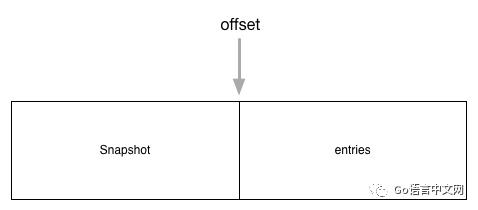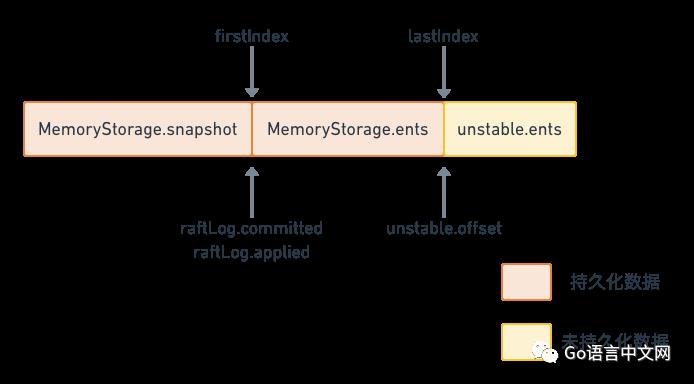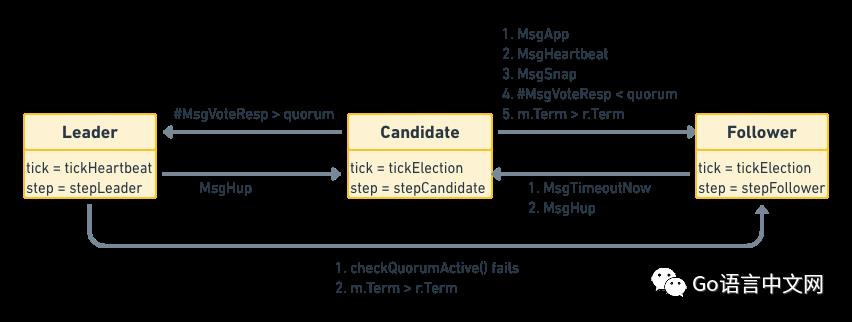面试官:聊聊 etcd 中的 Raft 吧
Posted Go语言中文网
tags:
篇首语:本文由小常识网(cha138.com)小编为大家整理,主要介绍了面试官:聊聊 etcd 中的 Raft 吧相关的知识,希望对你有一定的参考价值。
Raft:https://en.wikipedia.org/wiki/Raft_(computer_science "Raft") 是近年来比较流行的一个一致性算法。它的原理比较容易理解,网上也有很多相关的介绍,因此这里我就不再啰嗦原理了,而是打算以 raft 在 etcd 中的实现1[1]为例,从工程的角度来讲讲这个算法的一个具体实现,毕竟了解原理只算是“纸上谈兵”,离真正能把它应用起来还有很长一段距离。
如果你还不熟悉 raft,这个经典的动画演示[2]、它的论文[3]以及这个 lecture[4]可能会对你有帮助。或者你也可以直接观看下面的视频,这是我作的一次技术分享,讲的是etcd 中 raft 模块的源码解析[5]。说句题外话,很多 Conference 和 Meetup 都会把视频录像上传到 YouTube 上,YouTube 简直就是程序员的衣柜,每逛一次都有新收获。(方便播放,放一个 B 站链接)
https://www.bilibili.com/video/BV1Eb411B7RM
Overview
Etcd 将 raft 协议实现为一个 library,然后本身作为一个应用使用它。当然,可能是为了推广它所实现的这个 library,etcd 还额外提供了一个叫 raftexample[6] 的示例程序,向用户展示怎样在它所提供的 raft library 的基础上构建出一个分布式的 KV 存储引擎。
在 etcd 中,raft 作为底层的共识模块,运行在一个goroutine里,通过channel接受上层(etcdserver)传来的消息,并将处理后的结果通过另一个channel返回给上层应用,他们的交互过程大概是这样的:
这种全异步的交互方式好处就是它提高了性能,但坏处就是难以调试,代码看起来会很绕。拿 etcd 举例,很多时候你只看到它把一个消息 push 到一个 slice/channel 里面,然后这部分函数调用链就结束了,你无法直观的追踪到,到底是谁最后处理了这个消息。
Code Breakdown
我们来看一下这个 raft library 里面都有哪些文件:
$ tree --dirsfirst -L 1 -I '*test*' -P '*.go'
.
├── raftpb
├── doc.go
├── log.go
├── log_unstable.go
├── logger.go
├── node.go
├── progress.go
├── raft.go
├── rawnode.go
├── read_only.go
├── status.go
├── storage.go
└── util.go
下面按功能模块依次介绍:
raftpb
Raft 中的序列化是借助于Protocol Buffer[7]来实现的,这个文件夹就定义了需要序列化的几个数据结构,我们先从Entry和Message开始看起:
Entry
从整体上来说,一个集群中的每个节点都是一个状态机,而 raft 管理的就是对这个状态机进行更改的一些操作,这些操作在代码中被封装为一个个Entry。
// https://github.com/etcd-io/etcd/blob/v3.3.10/raft/raftpb/raft.pb.go#L203
type Entry struct {
Term uint64
Index uint64
Type EntryType
Data []byte
}
-
Term:选举任期,每次选举之后递增 1。它的主要作用是标记信息的时效性,比方说当一个节点发出来的消息中携带的 term 是 2,而另一个节点携带的 term 是 3,那我们就认为第一个节点的信息过时了。 -
Index:当前这个 entry 在整个 raft 日志中的位置索引。有了 Term和Index之后,一个 log entry 就能被唯一标识。 -
Type:当前 entry 的类型,目前 etcd 支持两种类型: EntryNormal [8]和 EntryConfChange [9],EntryNormal 代表当前 Entry 是对状态机的操作,EntryConfChange 则代表对当前集群配置进行更改的操作,比如增加或者减少节点。 -
Data:一个被序列化后的 byte 数组,代表当前 entry 真正要执行的操作,比方说如果上面的 Type是EntryNormal,那这里的 Data 就可能是具体要更改的 key-value pair,如果Type是EntryConfChange,那 Data 就是具体的配置更改项 ConfChange [10]。raft 算法本身并不关心这个数据是什么,它只是把这段数据当做 log 同步过程中的 payload 来处理,具体对这个数据的解析则有上层应用来完成。
Message
Raft 集群中节点之间的通讯都是通过传递不同的Message来完成的,这个Message结构就是一个非常 general 的大容器,它涵盖了各种消息所需的字段。
// https://github.com/etcd-io/etcd/blob/v3.3.10/raft/raftpb/raft.pb.go#L239
type Message struct {
Type MessageType
To uint64
From uint64
Term uint64
LogTerm uint64
Index uint64
Entries []Entry
Commit uint64
Snapshot Snapshot
Reject bool
RejectHint uint64
Context []byte
}
-
Type:当前传递的消息类型,它的取值有
很多个,但大致可以分成两类:
-
Raft 协议相关的,包括心跳 MsgHeartbeat、日志 MsgApp、投票消息 MsgVote 等。 -
上层应用触发的(没错,上层应用并不是通过 api 与 raft 库交互的,而是通过发消息),比如应用对数据更改的消息 MsgProp(osal)。
不同类型的消息会用到下面不同的字段:
-
To, From 分别代表了这个消息的接受者和发送者。 -
Term:这个消息发出时整个集群所处的任期。 -
LogTerm:消息发出者所保存的日志中最后一条的任期号,一般 MsgVote会用到这个字段。 -
Index:日志索引号。如果当前消息是 MsgVote的话,代表这个 candidate 最后一条日志的索引号,它跟上面的LogTerm一起代表这个 candidate 所拥有的最新日志信息,这样别人就可以比较自己的日志是不是比 candidata 的日志要新,从而决定是否投票。 -
Entries:需要存储的日志。 -
Commit:已经提交的日志的索引值,用来向别人同步日志的提交信息。 -
Snapshot:一般跟 MsgSnap合用,用来放置具体的 Snapshot 值。 -
Reject,RejectHint:代表对方节点拒绝了当前节点的请求(MsgVote/MsgApp/MsgSnap…)
log_unstable.go
顾名思义,unstable 数据结构用于还没有被用户层持久化的数据,它维护了两部分内容snapshot和entries:
// https://github.com/etcd-io/etcd/blob/v3.3.10/raft/log_unstable.go#L23
type unstable struct {
// the incoming unstable snapshot, if any.
snapshot *pb.Snapshot
// all entries that have not yet been written to storage.
entries []pb.Entry
offset uint64
logger Logger
}
entries代表的是要进行操作的日志,但日志不可能无限增长,在特定的情况下,某些过期的日志会被清空。那这就引入一个新问题了,如果此后一个新的follower加入,而leader只有一部分操作日志,那这个新follower不是没法跟别人同步了吗?所以这个时候snapshot就登场了 - 我无法给你之前的日志,但我给你所有之前日志应用后的结果,之后的日志你再以这个snapshot为基础进行应用,那我们的状态就可以同步了。因此它们的结构关系可以用下图表示2[11]:

这里的前半部分是快照数据,而后半部分是日志条目组成的数组 entries,另外 unstable.offset 成员保存的是 entries 数组中的第一条数据在 raft 日志中的索引,即第 i 条 entries 在 raft 日志中的索引为i + unstable.offset。
storage.go
这个文件定义了一个Storage[12]接口,因为 etcd 中的 raft 实现并不负责数据的持久化,所以它希望上面的应用层能实现这个接口,以便提供给它查询 log 的能力。
另外,这个文件也提供了Storage接口的一个内存版本的实现MemoryStorage[13],这个实现同样也维护了snapshot和entries这两部分,他们的排列跟unstable中的类似,也是snapshot在前,entries在后。从代码中看来etcdserver和raftexample都是直接用的这个实现来提供 log 的查询功能的。
log.go
有了以上的介绍 unstable、Storage 的准备之后,下面可以来介绍 raftLog 的实现,这个结构体承担了 raft 日志相关的操作。
raftLog 由以下成员组成:
-
storage Storage:前面提到的存放已经持久化数据的 Storage 接口。 -
unstable unstable:前面分析过的 unstable 结构体,用于保存应用层还没有持久化的数据。 -
committed uint64:保存当前提交的日志数据索引。 -
applied uint64:保存当前传入状态机的数据最高索引。
需要说明的是,一条日志数据,首先需要被提交(committed)成功,然后才能被应用(applied)到状态机中。因此,以下不等式一直成立:applied <= committed。
raftLog 结构体中,几部分数据的排列如下图所示2[14]:

这个数据排布的情况,可以从 raftLog 的初始化函数中看出来:
// https://github.com/etcd-io/etcd/blob/v3.3.10/raft/log.go#L45
// newLog returns log using the given storage. It recovers the log to the state
// that it just commits and applies the latest snapshot.
func newLog(storage Storage, logger Logger) *raftLog {
if storage == nil {
log.Panic("storage must not be nil")
}
log := &raftLog{
storage: storage,
logger: logger,
}
firstIndex, err := storage.FirstIndex()
if err != nil {
panic(err) // TODO(bdarnell)
}
lastIndex, err := storage.LastIndex()
if err != nil {
panic(err) // TODO(bdarnell)
}
log.unstable.offset = lastIndex + 1
log.unstable.logger = logger
// Initialize our committed and applied pointers to the time of the last compaction.
log.committed = firstIndex - 1
log.applied = firstIndex - 1
return log
}
因此,从这里的代码可以看出,raftLog 的两部分,持久化存储和非持久化存储,它们之间的分界线就是 lastIndex,在此之前都是Storage管理的已经持久化的数据,而在此之后都是unstable管理的还没有持久化的数据。
以上分析中还有一个疑问,为什么并没有初始化 unstable.snapshot 成员,也就是 unstable 结构体的快照数据?原因在于,上面这个是初始化函数,也就是节点刚启动的时候调用来初始化存储状态的函数,而 unstable.snapshot 数据,是在启动之后同步数据的过程中,如果需要同步快照数据时才会去进行赋值修改的数据,因此在这里并没有对它进行操作的地方。
progress.go
Leader 通过Progress这个数据结构来追踪一个 follower 的状态,并根据Progress里的信息来决定每次同步的日志项。这里介绍三个比较重要的属性:
// https://github.com/etcd-io/etcd/blob/v3.3.10/raft/progress.go#L37
// Progress represents a follower’s progress in the view of the leader. Leader maintains
// progresses of all followers, and sends entries to the follower based on its progress.
type Progress struct {
Match, Next uint64
State ProgressStateType
ins *inflights
}
-
用来保存当前 follower 节点的日志状态的属性:
在正常情况下,
Next = Match + 1,也就是下一个要同步的日志应当是对方已有日志的下一条。 -
Match:保存目前为止,已复制给该 follower 的日志的最高索引值。如果 leader 对该 follower 上的日志情况一无所知的话,这个值被设为 0。 -
Next:保存下一次 leader 发送 append 消息给该 follower 的日志索引,即下一次复制日志时,leader 会从 Next开始发送日志。 -
State属性用来保存该节点当前的同步状态,它会有一下几种取值3[15]:探测状态,当 follower 拒绝了最近的 append 消息时,那么就会进入探测状态,此时 leader 会试图继续往前追溯该 follower 的日志从哪里开始丢失的。在 probe 状态时,leader 每次最多 append 一条日志,如果收到的回应中带有
RejectHint信息,则回退Next索引,以便下次重试。在初始时,leader 会把所有 follower 的状态设为 probe,因为它并不知道各个 follower 的同步状态,所以需要慢慢试探。当 leader 确认某个 follower 的同步状态后,它就会把这个 follower 的 state 切换到这个状态,并且用
pipeline的方式快速复制日志。leader 在发送复制消息之后,就修改该节点的Next索引为发送消息的最大索引+1。接收快照状态。当 leader 向某个 follower 发送 append 消息,试图让该 follower 状态跟上 leader 时,发现此时 leader 上保存的索引数据已经对不上了,比如 leader 在 index 为 10 之前的数据都已经写入快照中了,但是该 follower 需要的是 10 之前的数据,此时就会切换到该状态下,发送快照给该 follower。当快照数据同步追上之后,并不是直接切换到 Replicate 状态,而是首先切换到 Probe 状态。
-
ProgressStateSnapshot -
ProgressStateReplicate -
ProgressStateProbe -
ins属性用来做流量控制,因为如果同步请求非常多,再碰上网络分区时,leader 可能会累积很多待发送消息,一旦网络恢复,可能会有非常大流量发送给 follower,所以这里要做 flow control。它的实现有点类似 TCP 的滑动窗口[16],这里不再赘述。
综上,Progress其实也是个状态机,下面是它的状态转移图:

raft.go
前面铺设了一大堆概念,现在终于轮到实现逻辑了。从名字也可以看出,raft 协议的具体实现就在这个文件里。这其中,大部分的逻辑是由Step函数驱动的。
// https://github.com/etcd-io/etcd/blob/v3.3.10/raft/raft.go#L752
func (r *raft) Step(m pb.Message) error {
//...
switch m.Type {
case pb.MsgHup:
//...
case pb.MsgVote, pb.MsgPreVote:
//...
default:
r.step(r, m)
}
}
Step的主要作用是处理不同的消息[17],所以以后当我们想知道 raft 对某种消息的处理逻辑时,到这里找就对了。在函数的最后,有个default语句,即所有上面不能处理的消息都落入这里,由一个小写的step函数处理,这个设计的原因是什么呢?
其实是因为这里的 raft 也被实现为一个状态机,它的step属性是一个函数指针,根据当前节点的不同角色,指向不同的消息处理函数:stepLeader[18]/stepFollower[19]/stepCandidate[20]。与它类似的还有一个tick函数指针,根据角色的不同,也会在tickHeartbeat[21]和tickElection[22]之间来回切换,分别用来触发定时心跳和选举检测。这里的函数指针感觉像实现了OOP里的多态。

node.go
node的主要作用是应用层(etcdserver)和共识模块(raft)的衔接。将应用层的消息传递给底层共识模块,并将底层共识模块共识后的结果反馈给应用层。所以它的初始化函数[23]创建了很多用来通信的channel,然后就在另一个goroutine里面开始了事件循环,不停的在各种channel中倒腾数据(貌似这种由for-select-channel组成的事件循环在 Go 里面很受欢迎)。
// https://github.com/etcd-io/etcd/blob/v3.3.10/raft/node.go#L286
for {
select {
case m := <-propc:
r.Step(m)
case m := <-n.recvc:
r.Step(m)
case cc := <-n.confc:
// Add/remove/update node according to cc.Type
case <-n.tickc:
r.tick()
case readyc <- rd:
// Cleaning after result is consumed by application
case <-advancec:
// Stablize logs
case c := <-n.status:
// Update status
case <-n.stop:
close(n.done)
return
}
}
propc和recvc中拿到的是从上层应用传进来的消息,这个消息会被交给 raft 层的Step函数处理,具体处理逻辑我上面有过介绍。
下面来解释下readyc的作用。在 etcd 的这个实现中,node并不负责数据的持久化、网络消息的通信、以及将已经提交的 log 应用到状态机中,所以node使用readyc这个channel对外通知有数据要处理了,并将这些需要外部处理的数据打包到一个Ready结构体中:
// https://github.com/etcd-io/etcd/blob/v3.3.10/raft/node.go#L52
// Ready encapsulates the entries and messages that are ready to read,
// be saved to stable storage, committed or sent to other peers.
// All fields in Ready are read-only.
type Ready struct {
// The current volatile state of a Node.
// SoftState will be nil if there is no update.
// It is not required to consume or store SoftState.
*SoftState
// The current state of a Node to be saved to stable storage BEFORE
// Messages are sent.
// HardState will be equal to empty state if there is no update.
pb.HardState
// ReadStates can be used for node to serve linearizable read requests locally
// when its applied index is greater than the index in ReadState.
// Note that the readState will be returned when raft receives msgReadIndex.
// The returned is only valid for the request that requested to read.
ReadStates []ReadState
// Entries specifies entries to be saved to stable storage BEFORE
// Messages are sent.
Entries []pb.Entry
// Snapshot specifies the snapshot to be saved to stable storage.
Snapshot pb.Snapshot
// CommittedEntries specifies entries to be committed to a
// store/state-machine. These have previously been committed to stable
// store.
CommittedEntries []pb.Entry
// Messages specifies outbound messages to be sent AFTER Entries are
// committed to stable storage.
// If it contains a MsgSnap message, the application MUST report back to raft
// when the snapshot has been received or has failed by calling ReportSnapshot.
Messages []pb.Message
// MustSync indicates whether the HardState and Entries must be synchronously
// written to disk or if an asynchronous write is permissible.
MustSync bool
}
应用程序得到这个Ready之后,需要:
-
将 HardState, Entries, Snapshot 持久化到 storage。 -
将 Messages 广播给其他节点。 -
将 CommittedEntries(已经 commit 还没有 apply)应用到状态机。 -
如果发现 CommittedEntries 中有成员变更类型的 entry,调用 node.ApplyConfChange()方法让node知道。 -
最后再调用 node.Advance()告诉 raft,这批状态更新处理完了,状态已经演进了,可以给我下一批 Ready 让我处理。
Life of a Request
前面我们把整个包的结构过了一遍,下面来结合具体的代码看看 raft 对一个请求的处理过程是怎样的。我一直觉得,如果能从代码的层面追踪到一个请求的处理过程,那无论是从宏观还是微观的角度,对理解整个系统都是非常有帮助的。
Life of a Vote Request
-
首先,在 node的大循环里,有一个会定时输出的tick channel,它来触发raft.tick()函数,根据上面的介绍可知,如果当前节点是 follower,那它的tick函数会指向tickElection。tickElection的处理逻辑是给自己发送一个MsgHup的内部消息,Step函数看到这个消息后会调用campaign函数,进入竞选状态。
// tickElection is run by followers and candidates after r.electionTimeout.
func (r *raft) tickElection() {
r.electionElapsed++
if r.promotable() && r.pastElectionTimeout() {
r.electionElapsed = 0
r.Step(pb.Message{From: r.id, Type: pb.MsgHup})
}
}
func (r *raft) Step(m pb.Message) error {
//...
switch m.Type {
case pb.MsgHup:
r.campaign(campaignElection)
}
}
-
campaign则会调用becomeCandidate把自己切换到 candidate 模式,并递增Term值。然后再将自己的Term及日志信息发送给其他的节点,请求投票。
func (r *raft) campaign(t CampaignType) {
//...
r.becomeCandidate()
// Get peer id from progress
for id := range r.prs {
//...
r.send(pb.Message{Term: term, To: id, Type: voteMsg, Index: r.raftLog.lastIndex(), LogTerm: r.raftLog.lastTerm(), Context: ctx})
}
}
-
另一方面,其他节点在接受到这个请求后,会首先比较接收到的 Term是不是比自己的大,以及接受到的日志信息是不是比自己的要新,从而决定是否投票。这个逻辑我们还是可以从Step函数中找到:
func (r *raft) Step(m pb.Message) error {
//...
switch m.Type {
case pb.MsgVote, pb.MsgPreVote:
// We can vote if this is a repeat of a vote we've already cast...
canVote := r.Vote == m.From ||
// ...we haven't voted and we don't think there's a leader yet in this term...
(r.Vote == None && r.lead == None) ||
// ...or this is a PreVote for a future term...
(m.Type == pb.MsgPreVote && m.Term > r.Term)
// ...and we believe the candidate is up to date.
if canVote && r.raftLog.isUpToDate(m.Index, m.LogTerm) {
r.send(pb.Message{To: m.From, Term: m.Term, Type: voteRespMsgType(m.Type)})
} else {
r.send(pb.Message{To: m.From, Term: r.Term, Type: voteRespMsgType(m.Type), Reject: true})
}
}
}
-
最后当 candidate 节点收到投票回复后,就会计算收到的选票数目是否大于所有节点数的一半,如果大于则自己成为 leader,并昭告天下,否则将自己置为 follower:
func (r *raft) Step(m pb.Message) error {
//...
switch m.Type {
case myVoteRespType:
gr := r.poll(m.From, m.Type, !m.Reject)
switch r.quorum() {
case gr:
if r.state == StatePreCandidate {
r.campaign(campaignElection)
} else {
r.becomeLeader()
r.bcastAppend()
}
case len(r.votes) - gr:
r.becomeFollower(r.Term, None)
}
}
Life of a Write Request
-
一个写请求一般会通过调用
node.Propose开始,Propose方法将这个写请求封装到一个MsgProp消息里面,发送给自己处理。 -
消息处理函数
Step无法直接处理这个消息,它会调用那个小写的step函数,来根据当前的状态进行处理。 -
如果当前是 follower,那它会把这个消息转发给 leader。
func stepFollower(r *raft, m pb.Message) error {
switch m.Type {
case pb.MsgProp:
//...
m.To = r.lead
r.send(m)
}
}
-
Leader 收到这个消息后(不管是 follower 转发过来的还是自己内部产生的)会有两步操作:
-
将这个消息添加到自己的 log 里 -
向其他 follower 广播这个消息
func stepLeader(r *raft, m pb.Message) error {
switch m.Type {
case pb.MsgProp:
//...
if !r.appendEntry(m.Entries...) {
return ErrProposalDropped
}
r.bcastAppend()
return nil
}
}
-
在 follower 接受完这个 log 后,会返回一个
MsgAppResp消息。 -
当 leader 确认已经有足够多的 follower 接受了这个 log 后,它首先会 commit 这个 log,然后再广播一次,告诉别人它的 commit 状态。这里的实现就有点像两阶段提交了。
func stepLeader(r *raft, m pb.Message) error {
switch m.Type {
case pb.MsgAppResp:
//...
if r.maybeCommit() {
r.bcastAppend()
}
}
}
// maybeCommit attempts to advance the commit index. Returns true if
// the commit index changed (in which case the caller should call
// r.bcastAppend).
func (r *raft) maybeCommit() bool {
//...
mis := r.matchBuf[:len(r.prs)]
idx := 0
for _, p := range r.prs {
mis[idx] = p.Match
idx++
}
sort.Sort(mis)
mci := mis[len(mis)-r.quorum()]
return r.raftLog.maybeCommit(mci, r.Term)
}
Conclusion
Etcd 里的 raft 模块只实现了 raft 共识算法,而像消息的网络传输,数据存储都由上层应用来完成。这篇文章先介绍了基本的数据结构,然后在这些数据结构的基础上引入了 raft 算法。同时,这里还以一个投票请求和写请求为例,介绍了一个请求从接受到应答的完整处理过程。
但到目前为止,我们还有很多细节没有涉及,比如说 Linearizable Read,snapshot 机制,WAL 的存储与回放,所以希望你能以这篇文章为基础,顺藤摸瓜,继续深入研究下去。
-
到写这篇文章为止,etcd 的最新版本为 v3.3.10 [24],所以这里的分析都是以 v3.3.10 为基础。
原文链接:https://blog.betacat.io/post/raft-implementation-in-etcd/
参考资料
1: https://blog.betacat.io/post/raft-implementation-in-etcd/#fn:1
[2]动画演示: http://thesecretlivesofdata.com/raft/
[3]它的论文: https://raft.github.io/raft.pdf
[4]这个 lecture: https://www.youtube.com/watch?v=YbZ3zDzDnrw
[5]etcd 中 raft 模块的源码解析: https://reading.developerlearning.cn/reading/32-2019-03-02-etcd-raft/
[6]raftexample: https://github.com/etcd-io/etcd/tree/v3.3.10/contrib/raftexample
[7]Protocol Buffer: https://developers.google.com/protocol-buffers/
[8]EntryNormal: https://github.com/etcd-io/etcd/blob/v3.3.10/raft/raftpb/raft.pb.go#L47
[9]EntryConfChange: https://github.com/etcd-io/etcd/blob/v3.3.10/raft/raftpb/raft.pb.go#L48
[10]ConfChange: https://github.com/etcd-io/etcd/blob/v3.3.10/raft/raftpb/raft.pb.go#L283
[11]2: https://blog.betacat.io/post/raft-implementation-in-etcd/#fn:2
[12]Storage: https://github.com/etcd-io/etcd/blob/v3.3.10/raft/storage.go#L46
[13]MemoryStorage: https://github.com/etcd-io/etcd/blob/v3.3.10/raft/storage.go#L74
[14]2: https://blog.betacat.io/post/raft-implementation-in-etcd/#fn:2
[15]3: https://blog.betacat.io/post/raft-implementation-in-etcd/#fn:3
[16]滑动窗口: https://en.wikipedia.org/wiki/Sliding_window_protocol
[17]消息: https://blog.betacat.io/post/raft-implementation-in-etcd/#message
[18]stepLeader: https://github.com/etcd-io/etcd/blob/v3.3.10/raft/raft.go#L875
[19]stepFollower: https://github.com/etcd-io/etcd/blob/v3.3.10/raft/raft.go#L1121
[20]stepCandidate: https://github.com/etcd-io/etcd/blob/v3.3.10/raft/raft.go#L1079
[21]tickHeartbeat: https://github.com/etcd-io/etcd/blob/v3.3.10/raft/raft.go#L608
[22]tickElection: https://github.com/etcd-io/etcd/blob/v3.3.10/raft/raft.go#L598
[23]初始化函数: https://github.com/etcd-io/etcd/blob/v3.3.10/raft/node.go#L243
[24]v3.3.10: https://github.com/etcd-io/etcd/tree/v3.3.10
推荐阅读
以上是关于面试官:聊聊 etcd 中的 Raft 吧的主要内容,如果未能解决你的问题,请参考以下文章